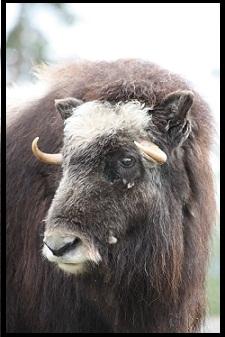The activity of musk ox housed in different conditions.

The activity rate was higher in Tännäs (4.7 km/day respectively 1.9-2.2 km/day) and that the terrain was more rugged compared to Kolmården. It has been shown in earlier studies that the musk ox moves in a higher degree during the summer period compared to calving and winter period (Jingfors, 1982; Reynolds, et al. 1998; Lent, 1988). Another explanation for the different activity rate could be the different age on the animals. In a study by Sarrazin and Legendre (2000), it was shown that it was better to reintroduce captive younger animals to a wild population, because of their higher surviving rate and better adaption to the new habitat and herb, than the older ones.
The investigations have shown that the activity patterns of the musk ox was significant higher between baseline and delude feeding in snow and between changed feeding place and delude feeding in snow (p > 0.05).
A correlation between the average activity and the ambient temperature, it shows a negative correlation in Tännäs (-0.449) and in Kolmården it was different between the different treatments. A negative correlation for the baseline (-0.020) and deluded feeding in snow (-0.022), and a positive correlation for the changed feeding place treatment (0.102). A negative correlation means that, when the temperature was high the activity was low. A negative correlation means that, when the temperature was high the activity was low. One explanation could be the animals thick under wool which protect the animal against temperatures below -40 ºC, becomes a problem in the summer (Ytrehus et al, 2008; Munn and Barboza, 2007; Crater and Barboza, 2007). When an animal in captivity got warm it decreases its activity, because of problems to found any area to cool down in, and not getting over heated. One system that could help the musk ox to decrease the body temperature is the nasal mucosa. The temporal exchanger in musk ox is instrumental in the conservation of heat and water. Exchanger efficiency is temperature depending reaching up to 75% of heat recovery and 80% of water recovery. This system also helps to decrease the brain temperature by the circle of Willis-sinus cavernosus. The musk ox have this system like other animals, but it needs more studies to investigate if the musk ox has the same effectively system like the caribou (Blix, 2005).
Responsible for this page:
Director of undergraduate studies Biology
Last updated:
05/17/11
